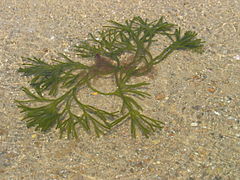- Codium fragile
-
Codium fragile 
Codium fragile off the Massachusetts coast Scientific classification Kingdom: Plantae Division: Chlorophyta Class: Bryopsidophyceae Order: Bryopsidales Family: Codiaceae Genus: Codium Species: C. fragile Binomial name Codium fragile
(Suringar) HariotCodium fragile, also known as Green sea fingers, Dead man's fingers, felty fingers,[1] felt-alga,[2] Green sponge and [3] Green fleece[4] is an invasive species of seaweed in the family Codiaceae.
This siphonous alga is dark green in colour. It appears as a fuzzy patch of tubular fingers. These formations hang down from rocks during low tide, hence the nickname "dead man's fingers".[5] The branches, or fingers, are up to 1 cm wide, and can extend to lengths of over 30 cm.
Codium fragile occurs in the low intertidal zone, and subtidal on high energy beaches.
It has no asexual (sporophyte) stage, and male and female gametes are both produced on separate plants.
Contents
Subspecies
Subspecies of C. fragile can only be distinguished microscopically.
Codium fragile subsp. atlanticum
Codium fragile subsp. atlanticum (A. Cotton) Silva, is known to have arrived in the southwest of Ireland around 1808. From there it may have spread by rafting or floating in the sea. Approximately 30 years later, it was found in Scotland. Codium fragile subsp. atlanticum is thought to have originally come from the Pacific Ocean near Japan.
Since 1840, when it was first discovered in Scotland, it has spread the entire length of Britain, including Shetland. Between 1949 and 1955 it is known to have spread between Berwick-upon-Tweed and St. Andrews, Fife, a distance of 80 km. Populations of this algae occur mostly in northern Britain. Elsewhere in Europe, it is found only in Norway.
This species displaces the native Codium tomentosum.
Codium fragile subsp. atlanticum is used as food in the Far East.[6]
Codium fragile subsp. tomentosoides
The subspecies Codium fragile subsp. tomentosoides (van Goor) P.C. Silva[7][8], (synonym Codium mucronatum var. tomentosoides (van Goor)), commonly known as dead man's fingers, green fleece, green sea fingers, oyster thief, and Sputnik weed, occurs along nearly the whole coastline of the eastern United States, from the Gulf of St. Lawrence in Canada to North Carolina. It is a rapidly spreading invasive species.[1]
It originated in the Pacific Ocean around Japan, and was introduced into New York from Europe in 1957. Its presence was first recorded in 1964 in the Gulf of Maine at Booth Bay.
This is a dominant subspecies in the subtidal zone, attaching to almost any hard surface. This results in increased maintenance labor for aquaculturists, while reducing the productivity of cultured species of marine life. In established shellfish beds, this species can become a nuisance; when wave energy lifts the alga, it floats away and carries the host shellfish away with it. This is the source of the common name "oyster thief".[4]
This subspecies was introduced from Asiatic coasts of the Pacific to Norway, and to Denmark in 1919.[6]
References
- ^ a b Codium fragile
- ^ Codium fragile (Suringar) Hariot - Encyclopedia of Life
- ^ Marine Invasive Species in Nova Scotia - Codium
- ^ a b http://www.mass.gov/czm/invasives/docs/invaders/c_fragile.pdf
- ^ Codium fragile index
- ^ a b Codium fragile subsp. atlanticum
- ^ issg Database: Ecology of Codium fragile ssp. tomentosoides
- ^ MIT Sea Grant | Introduced Species Descriptions
Further reading
- Hardy, F.G. 1990. The green seaweed Codium fragile on the Berwickshire coast. History of the Berwickshire Naturalists' Club
External links
Categories:
Wikimedia Foundation. 2010.
